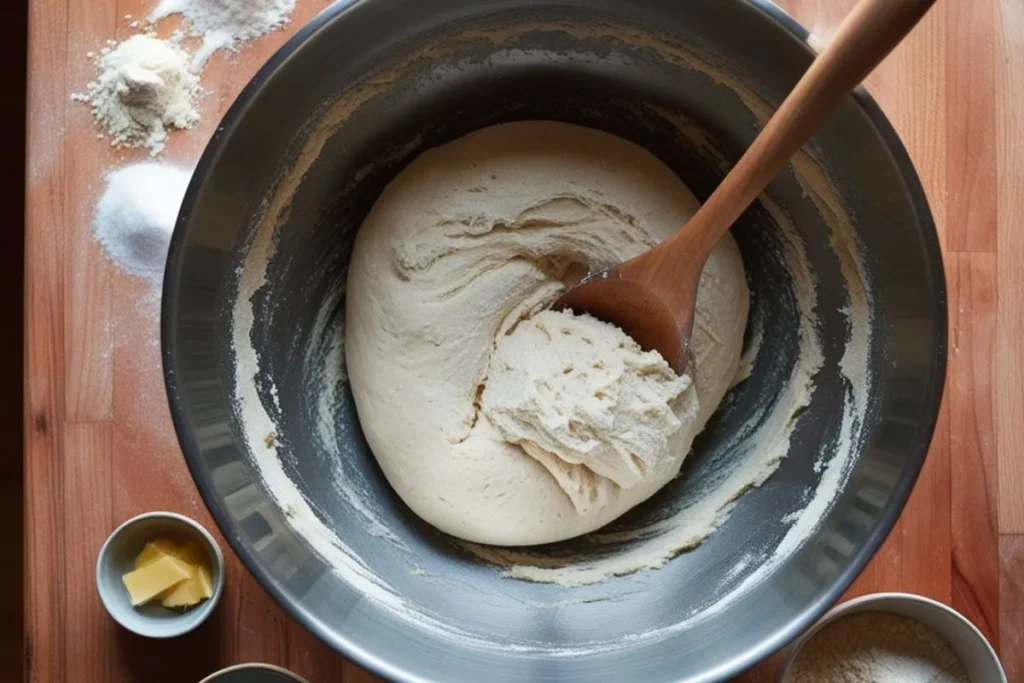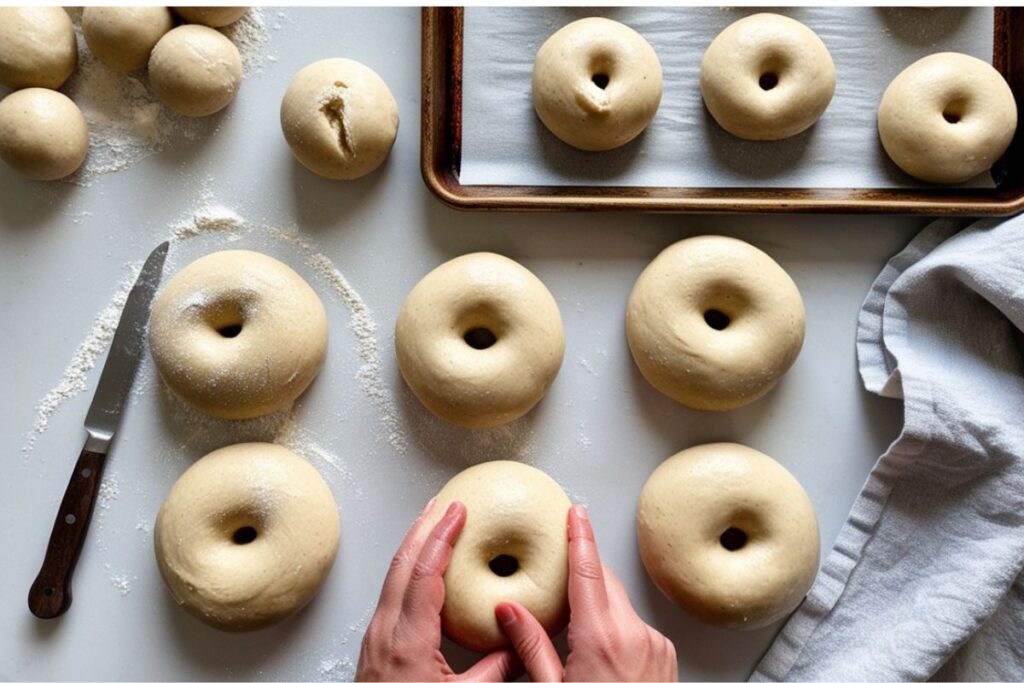Sourdough Bagels
Introduction
There’s something undeniably special about sourdough bagels. Their chewy texture, tangy flavor, and golden crust are a far cry from your standard bagel. If you’ve ever wondered how to make sourdough bagels from scratch, this guide is for you! Making sourdough bagels can seem intimidating at first, but with the right tools and knowledge, you’ll be able to bake delicious bagels right in your own kitchen.
Whether you’re an experienced baker or a complete beginner, making sourdough bagels is a rewarding process. In this article, we’ll walk you through everything you need to know — from creating your own sourdough starter to boiling and baking the perfect bagels. Plus, we’ll share tips and troubleshooting advice to ensure your bagels turn out just right.
Let’s get started with making your very own homemade sourdough bagels!
Table of Contents
Why Choose Sourdough Bagels?

It’s hard to resist the allure of a freshly baked bagel. But sourdough bagels bring something extra to the table. While a traditional bagel relies on commercial yeast for rising, sourdough bagels are made using a naturally fermented starter. This process imparts a distinct, tangy flavor that you just won’t get from regular bagels.
Not only do sourdough bagels taste amazing, but they are also a healthier choice. The long fermentation process breaks down gluten and makes the dough easier to digest. Plus, sourdough fermentation improves the bagels’ texture, resulting in a chewy, airy interior and a perfectly crispy crust. If you’re looking to elevate your bagel game, sourdough is the way to go.
What You Need to Make Sourdough Bagels
Before you dive into the recipe, it’s important to gather all the necessary ingredients and tools. Here’s a quick list of everything you’ll need:
Ingredients for the Bagels:
- 2 cups of bread flour (for chewy texture)
- 1 cup of active sourdough starter (100% hydration, or equal parts water and flour)
- 1 tsp of salt
- 1 tbsp of honey or malt syrup (for a slightly sweet flavor)
- 1 cup of water (room temperature)
- 1 tbsp of olive oil (optional, for added richness)
For Boiling the Bagels:
- 4 quarts of water
- 2 tbsp of baking soda (for a golden, chewy crust)
- 1 tbsp of malt syrup or honey (optional, for extra flavor)
Tools You’ll Need:
- Large mixing bowl (for the dough)
- Stand mixer (optional, but helpful for kneading)
- Large pot (for boiling)
- Baking sheet or pizza stone (for baking)
- Dough scraper (for shaping)
- Slotted spoon or spider strainer (for boiling)
Once you have everything in place, you’re ready to start baking!
How to Make Sourdough Bagels: Step-by-Step Recipe
Step 1: Prepare the Dough

Start by combining your sourdough starter, flour, water, and honey/malt syrup in a large mixing bowl. If you’re using a stand mixer, fit it with a dough hook and knead the dough on low speed for about 6-8 minutes, until it becomes smooth and elastic. If you’re doing it by hand, you can knead it on a floured surface.
Once the dough comes together, add the salt and knead it for another minute or two. The dough should be firm yet flexible. If it’s too sticky, add a little more flour; if it’s too dry, mix in a splash of water. The dough should be soft and pliable.
Step 2: Bulk Fermentation

Once your dough is kneaded, shape it into a ball and place it in a lightly oiled bowl. Cover the bowl with a damp towel or plastic wrap and allow it to rest at room temperature for 4-6 hours, or until it has roughly doubled in size. This is the bulk fermentation stage, and it’s where the sourdough starter works its magic to develop that signature tangy flavor.
During fermentation, you can perform a series of stretch and folds to help strengthen the dough. Every 30 minutes for the first 2 hours, gently stretch and fold the dough. This helps with gluten development and gives you that perfect bagel texture.
Step 3: Shape the Bagels

Once the dough has fermented, turn it out onto a lightly floured surface and divide it into 8 equal pieces. Form each piece into a ball and allow them to rest for approximately 10 minutes.
Once rested, take each dough ball and use your thumb to create a hole in the center. Stretch the hole gently to form the classic bagel shape. Be sure to make the hole a bit larger than you think it should be, as it will shrink while boiling.
Arrange the shaped bagels on a parchment-lined baking sheet, cover them with a cloth, and let them rest for 30 minutes to 1 hour. This allows the dough to relax and rise a bit.
Step 4: Boil the Bagels

While the bagels are resting, fill a large pot with about 4 quarts of water and bring it to a boil. Add 2 tablespoons of baking soda to the water along with 1 tablespoon of malt syrup or honey (optional, but it helps give the bagels a beautiful golden-brown color). The baking soda will help create that signature chewy, shiny crust on your sourdough bagels.
When the water reaches a boil, carefully lower the bagels into the water, a few at a time (2-3). Boil each bagel for about 1-2 minutes, flipping halfway through. Use a slotted spoon or spider strainer to remove the bagels and set them on a clean towel or cooling rack to drain.
Step 5: Bake the Bagels

Preheat your oven to 425°F (220°C). Transfer the boiled bagels onto a baking sheet or preheated pizza stone. If you like, top the bagels with sesame seeds, poppy seeds, or everything bagel seasoning.
Bake the bagels for 20-25 minutes, or until they are golden brown and produce a hollow sound when tapped on the bottom. The crust should be crispy, and the inside should be chewy and airy.
Take the bagels out of the oven and allow them to cool on a wire rack before serving.
Troubleshooting Common Issues with Sourdough Bagels
Even the most experienced bakers run into problems now and then. Here are a few common issues you may face, along with tips for troubleshooting them:
- Bagels too dense: If your bagels are too dense, they might not have proofed long enough. Ensure you allow enough time for fermentation and shaping. You can also increase the hydration in your dough.
- Bagels too flat: If your bagels spread out too much while baking, try shaping them a bit tighter or reducing the resting time to prevent over-proofing.
- Undercooked interior: If your bagels look golden on the outside but are still doughy inside, make sure your oven is fully preheated, and bake them for a few more minutes.
Tips for Perfect Sourdough Bagels
Here are some additional tips to help you make perfect sourdough bagels every time:
- Use bread flour: Bread flour has a higher protein content, which gives bagels their characteristic chewiness. Avoid using all-purpose flour if possible.
- Hydration level: A higher hydration dough (more water) will result in a softer bagel. If you like a chewier bagel, stick to a slightly firmer dough.
- Boiling time: Don’t skip the boiling process — it’s what gives bagels their characteristic chewy texture and shiny crust.
- Flavor variations: Get creative with your bagels! You can add everything bagel seasoning, cinnamon and raisins, or even herbs and cheese to the dough.
Creative Sourdough Bagel Variations
While plain sourdough bagels are delicious, there are plenty of fun variations to try:
- Cinnamon Raisin Sourdough Bagels: Add cinnamon and raisins to the dough before shaping.
- Cheddar Jalapeño Bagels: Incorporate shredded cheddar cheese and finely chopped jalapeños into the dough for a flavorful, spicy kick.
- Everything Bagels: Top your bagels with sesame seeds, poppy seeds, garlic flakes, and onion flakes for that classic everything bagel experience.
How to Store and Serve Sourdough Bagels
Once your bagels have cooled, store them in an airtight container at room temperature for up to 3 days. For longer storage, you can freeze the bagels and reheat them later.
Sourdough bagels are perfect for breakfast with a spread of cream cheese or smoked salmon. You can also use them for sandwiches or pair them with a warm cup of coffee.
Additional Tips for Perfecting Sourdough Bagels
Achieving the perfect sourdough bagels takes patience and careful attention to detail. Here are some pro tips to ensure your bagels come out deliciously every time:
- Hydration is Key: Sourdough dough can be a bit more hydrated than typical bread dough, so make sure to adjust the water content as needed. If the dough feels too dry while mixing, add a little extra water, one tablespoon at a time, until you achieve the right consistency. The dough should be soft to the touch, but not overly sticky.
- Use a Dutch Oven for Boiling: When boiling the bagels, using a large, deep pot or a Dutch oven helps maintain a consistent temperature. A good rolling boil is essential to create that chewy, crisp texture that defines a bagel. Adding a teaspoon of baking soda or malt syrup to the water can also help achieve a darker, shinier crust.
- Rest Time: Don’t rush the proofing process! Letting the dough rest and rise is essential for flavor development, especially with sourdough. For best results, allow your bagels to rest for a full hour (or even overnight in the fridge) for an extra tangy flavor.
- Shaping Matters: For uniform bagels, make sure to shape the dough evenly, ensuring each piece is the same size. This ensures that they cook at the same rate and results in an even texture throughout.
- Baking on a Preheated Stone: To get a nice, crispy bottom, bake your bagels on a preheated baking stone or pizza stone. This mimics the effect of a traditional bagel oven, creating a crisp, golden crust while maintaining a tender interior.
Troubleshooting Common Bagel-Making Problems
Even experienced bakers can face challenges while making sourdough bagels. If you run into any of the following issues, don’t worry! Here’s how to fix them:
- Bagels Are Too Dense or Hard
Solution: This could be due to overworking the dough or not giving it enough time to rise. Make sure you allow for a long proofing period, and don’t knead the dough excessively, as this can prevent the bagels from becoming light and airy. Try giving the dough a second rise to help with texture. - Bagels Are Too Puffy or Hollow Inside
Solution: If your bagels are too puffed up and hollow, it might be due to overproofing or using too much yeast in your sourdough starter. To prevent this, monitor your dough’s rise carefully, and always check that it has just doubled in size before shaping and baking. - Bagels Won’t Hold Their Shape
Solution: If your bagels spread out too much while baking or lose their shape, they might need a bit more time resting before being boiled. Ensure they’ve had enough time to rise before dropping them into the boiling water. You can also try shaping them a little tighter. - Bagels Are Too Soft or Doughy Inside
Solution: This could happen if the bagels were undercooked. Double-check that your oven is fully preheated, and use a thermometer to ensure the internal temperature reaches at least 200°F (93°C). A good test for doneness is to tap the bottom of the bagel – it should sound hollow.
Creative Bagel Variations
Once you master the basic sourdough bagel recipe, feel free to get creative with different flavors and toppings! Here are some exciting variations to try:
- Cinnamon Raisin Bagels: Add 1-2 teaspoons of cinnamon and 1/2 cup of raisins to your dough. Roll the dough with a bit of cinnamon sugar for extra flavor. These make for a perfect sweet breakfast treat!
- Garlic and Herb Bagels: Mix in minced garlic, dried oregano, rosemary, or thyme into the dough. After boiling, sprinkle with a little garlic salt and dried herbs for a savory twist.
- Cheese Bagels: Fold in shredded cheese like cheddar or mozzarella directly into the dough for a cheesy interior. For extra flavor, sprinkle some cheese on top before baking for a golden crust.
- Everything Bagels: Top your bagels with everything bagel seasoning (a blend of sesame seeds, poppy seeds, garlic, onion, and salt). This classic bagel topping is always a crowd favorite and adds a savory, crunchy topping.
- Spicy Jalapeño Bagels: Add finely chopped jalapeños or chili flakes to the dough for a spicy kick. You can also top them with cheese for a savory contrast.
- Sun-Dried Tomato and Basil Bagels: Mix in chopped sun-dried tomatoes and fresh basil into your dough for an Italian-inspired bagel. These pair wonderfully with cream cheese or goat cheese.
Health-Conscious Adjustments for Sourdough Bagels
If you’re looking to make your sourdough bagels a bit healthier, here are some easy swaps:
- Whole Wheat Flour: For a heartier, more nutritious bagel, swap in some whole wheat flour for part of the all-purpose flour. Begin by substituting 25-50% of the flour with whole wheat to preserve the texture, or go for a completely whole wheat version for a heartier bagel.
- Reduce the Sugar: Traditional bagel recipes often call for a little sugar to activate the yeast. For a more health-conscious version, you can cut down on sugar or substitute with natural sweeteners like honey or maple syrup in small amounts.
- Use Olive Oil: Instead of butter, try using olive oil in the dough. Olive oil is a healthier fat option and adds a nice richness to the bagels without the added saturated fats.
- Gluten-Free Option: If you or your guests are gluten-free, you can make gluten-free sourdough bagels by using a gluten-free flour blend and adjusting the recipe accordingly. Be sure to also include xanthan gum or psyllium husk to give the dough structure.
- Add More Fiber: Boost the fiber content of your bagels by adding ground flaxseed, chia seeds, or psyllium husk to the dough. These additions will help keep you fuller for longer and provide extra health benefits.
- Dairy-Free: If you prefer a dairy-free version, simply omit any milk or cream cheese toppings and substitute with a plant-based milk (like almond or oat milk) and a dairy-free butter.
Nutritional Benefits of Sourdough Bagels
While sourdough bagels are a delicious treat, they can also provide several nutritional benefits, especially when made with whole grains or healthy fat options. Here’s a breakdown of why sourdough bagels can be a great addition to your diet:
- Probiotic Benefits: Sourdough bread is naturally fermented, which means it contains beneficial probiotics that are good for gut health. These probiotics help with digestion and improve the overall health of your microbiome.
- Higher Fiber Content: If you opt for whole wheat flour or add seeds to your bagels, you’ll increase their fiber content. Fiber is crucial for digestive health and can assist in regulating blood sugar levels.
- Lower Glycemic Index: Because of the fermentation process, sourdough has a lower glycemic index compared to other types of bread. This means it causes a slower, more gradual rise in blood sugar levels, which is beneficial for those managing diabetes or looking to maintain steady energy levels.
- Rich in Protein: Sourdough bagels, like all yeast-leavened breads, contain protein, which is important for muscle repair, immune function, and overall cell health.
“Please note that the nutritional information provided is for general guidance and may vary depending on specific brands, preparation methods, and portion sizes.”
Conclusion
Making sourdough bagels from scratch is a rewarding and enjoyable process. With a bit of patience and the right technique, you’ll be able to create bagels with an incredible flavor and texture that are far superior to store-bought ones. Whether you’re making them for breakfast or serving them at brunch, these bagels will impress everyone at the table.
Now that you know how to make perfect sourdough bagels, why not give it a try? Experiment with different flavors and share your creations with friends and family. Happy baking!

